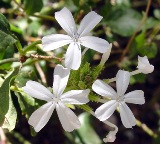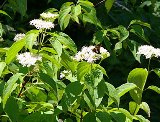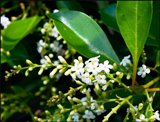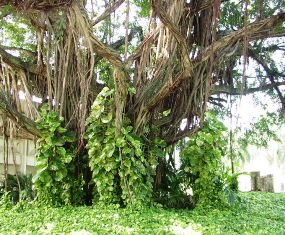Discover Florida Nature
It's time to explore the natural Florida


|
|
|
|
|
 Doctorbush
(Plumbago scandens)- The doctorbush is a shrub vine of the
genus Plumbago. Its duration is perennial which means it will grow year
after year. Doctorbush’s floral region is North America US Lower 48,
Puerto Rico and The Virgin Islands, specifically in the states of
Arizona, Florida and Texas. The doctorbush, or summer snow, as it is
sometimes called, is a flowering shrub. The flowers have a long blooming
season and attract butterflies. The leaves are dark green, simple, and
oval-shaped. These sprawling, native shrubs grow in shaded canyons. Doctorbush
(Plumbago scandens)- The doctorbush is a shrub vine of the
genus Plumbago. Its duration is perennial which means it will grow year
after year. Doctorbush’s floral region is North America US Lower 48,
Puerto Rico and The Virgin Islands, specifically in the states of
Arizona, Florida and Texas. The doctorbush, or summer snow, as it is
sometimes called, is a flowering shrub. The flowers have a long blooming
season and attract butterflies. The leaves are dark green, simple, and
oval-shaped. These sprawling, native shrubs grow in shaded canyons.  Dogwood-Swamp
Dogwood (Cornus foemina)- Also known as the stiff dogwood
because of its rigid upright branches, this plant gets far less
attention than its famous cousin. Swamp dogwood is a small
deciduous tree, or, more often, a multi-trunked shrub that rarely
exceeds 15 feet in height. Branches form off the main trunk close to the
ground, and the crown is broad and rounded. Although not as showy as the
flowering dogwood, swamp dogwood is an attractive plant. Large, open
clusters of white flowers begin blooming in late March and early April.
This is several weeks after the new leaves have formed. The individual
flowers resemble those of the viburnums, but the clusters are larger,
and they attract many pollinating insects. Swamp dogwood fruit is
relished by a wide variety of songbirds and other animals. The broad
clusters of bluish, žinch fruit ripen by midsummer. Although it is
normally found in swampy areas or along stream banks, swamp dogwood is
fairly adaptable when used in the home landscape. Dogwood-Swamp
Dogwood (Cornus foemina)- Also known as the stiff dogwood
because of its rigid upright branches, this plant gets far less
attention than its famous cousin. Swamp dogwood is a small
deciduous tree, or, more often, a multi-trunked shrub that rarely
exceeds 15 feet in height. Branches form off the main trunk close to the
ground, and the crown is broad and rounded. Although not as showy as the
flowering dogwood, swamp dogwood is an attractive plant. Large, open
clusters of white flowers begin blooming in late March and early April.
This is several weeks after the new leaves have formed. The individual
flowers resemble those of the viburnums, but the clusters are larger,
and they attract many pollinating insects. Swamp dogwood fruit is
relished by a wide variety of songbirds and other animals. The broad
clusters of bluish, žinch fruit ripen by midsummer. Although it is
normally found in swampy areas or along stream banks, swamp dogwood is
fairly adaptable when used in the home landscape.  (Florida)
Fiddlewood (Citharexylum spinosum L)- Fiddlewood grows as an
evergreen shrub or small tree in and around coastal areas of Central and
South Florida and the Keys. It is native to Florida and the West Indies.
Fiddlewood has heavy, very hard, close grained wood that has bright red
heartwood and lighter colored sap wood. The tree has no commercial value
other than as a landscape plant where it is often grown as a shrub,
6'-8' in height. Fiddlewood is salt tolerant and can withstand winds,
making it an excellent landscape plant for coastal areas in warm
climates. The small, five-lobed, white flowers of fiddlewood appear
throughout the year. These flowers are quite fragrant and are an
excellent nectar source for wildlife. The berries of the fiddlewood also
provide a food source for wildlife. (Florida)
Fiddlewood (Citharexylum spinosum L)- Fiddlewood grows as an
evergreen shrub or small tree in and around coastal areas of Central and
South Florida and the Keys. It is native to Florida and the West Indies.
Fiddlewood has heavy, very hard, close grained wood that has bright red
heartwood and lighter colored sap wood. The tree has no commercial value
other than as a landscape plant where it is often grown as a shrub,
6'-8' in height. Fiddlewood is salt tolerant and can withstand winds,
making it an excellent landscape plant for coastal areas in warm
climates. The small, five-lobed, white flowers of fiddlewood appear
throughout the year. These flowers are quite fragrant and are an
excellent nectar source for wildlife. The berries of the fiddlewood also
provide a food source for wildlife.Fig Trees-There are two types of native fig tress in the state of Florida. The strangle fig and the lesser known shortleaf fig. Among trees, the figs (Ficus spp.) have bizarre growth forms and unusual ways to produce fruit and seed. Many have numerous snakelike, aerial roots growing downward from the limbs and aggressive growth habits that can strangle other trees.  Strangler
Fig (Ficus aurea) - The strangler fig, also called golden fig,
is a large and fast-growing tree with a fascinating life history. The
tree is native to coastal areas of south Florida, the Keys, and the West
Indies and has made its way into central Florida. Strangler fig begins
its life as a parasite as its seed lodges in the cracks and crevices of
the bark of a host. Cabbage palms are favorite hosts. The seed
germinates and sends out air roots. These air roots take in nutrients
and water from the air and host tree. Eventually the air roots grow to
reach the ground and develop their own underground root system,
independent of the host tree. Often during this process, the strangler
fig may cover the host tree with its own trunk and strangle the host
tree, hence the common name. New branches grow and if these reach the
ground, they will send out new shoots and roots. Over time, this can
create a compound structure of trees that covers a large area. Strangler
Fig (Ficus aurea) - The strangler fig, also called golden fig,
is a large and fast-growing tree with a fascinating life history. The
tree is native to coastal areas of south Florida, the Keys, and the West
Indies and has made its way into central Florida. Strangler fig begins
its life as a parasite as its seed lodges in the cracks and crevices of
the bark of a host. Cabbage palms are favorite hosts. The seed
germinates and sends out air roots. These air roots take in nutrients
and water from the air and host tree. Eventually the air roots grow to
reach the ground and develop their own underground root system,
independent of the host tree. Often during this process, the strangler
fig may cover the host tree with its own trunk and strangle the host
tree, hence the common name. New branches grow and if these reach the
ground, they will send out new shoots and roots. Over time, this can
create a compound structure of trees that covers a large area. |
|
|
Advertise | Privacy Statement | Dog Encyclopedia | Video |Contact | Alaska Nature |
|